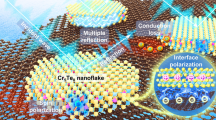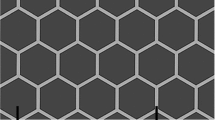Abstract
The Co71.8Fe4.9Nb0.8Si7.5B15 amorphous glass-covered wires (AGCW) are prepared by the Taylor-Ulitovsky technique. The frequency dependence of asymmetrical giant magneto-impedance (AGMI) effect in amorphous glass-covered wires annealed by 70 mA DC current is here presented. The resistance R and the reactance X have been measured, respectively. The real part R and the imaginary part X of impedance play an important role at high frequency and low frequency, respectively. The influence of DC bias current from Ib = 0 mA to Ib = 5 mA at 30 MHz on the GMI effect in the glass-covered wires annealed by 70 mA DC current is investigated. The asymmetry becomes the largest around Ib=1 mA, and finally decreases for the larger bias current Ib=5 mA. The maximum ΔZ/Z ratio of 310% is observed at 58 MHz under 1 mA bias current.
Similar content being viewed by others
References
Panina L V, Mohri K. Magneto-Impedance Effect in Amorphous Wires [J]. Appl Phys Lett, 1994, 65(9): 1189.
Mohri K, Uchiyama T, Panina L V. Recent Advances of Micro-Magnetic Sensors and Sensing Application [J]. Sensors and Actuators A, 1997, 59: 1.
Panina L V, Mohri K. Magneto-Impedance in Multilayer Films [J]. Sensors and Actuators A, 2000, 81: 71.
Honkura Y. Development of Amorphous Wire Type MI Sensors for Automobile Use [J]. J Magn Magn Mater, 2002, 249 (1-2): 375.
Panina L V, Makhnovskiy D P, Mohri K. Magnetoimpedance in Amorphous Wires and Multifunctional Applications: From Sensors to Tunable Artificial Microwave Materials [J]. J Magn Magn Mater, 2004, 272: 1452.
Valenzuela R, Vazquez M, Hernando A. A Position Sensor Based on Magnetoimpedance [J]. J Appl Phys, 1996, 79(8): 6549.
Velázquez J, Váazquez M, Chen D X, et al. Giant Magnetoimpedance in Nonmagnetostrictive Amorphous Wires [J]. Phys Rev B, 1994, 50: 16737.
Vazquez M, Chen D X. The Magnetization Reversal Process in Amorphous Wires [J]. IEEE Trans Magn, 1995, 31: 1229.
Wiesner H, Schneider J. Magnetic Properties of Amorphous Fe-P Alloys Containing Ga, Ge and As [J]. Phys Stat Sol, 1974, 26(A): 71.
Beach R S, Smith N, Piatt C L, et al. Magneto-Impedance Effect in NiFe Plated Wire [J]. Appl Phys Lett, 1996, 68: 2753.
Kraus L, Frait Z, Pirota K R, et al. Giant Magneto-Impedance in Glass-Covered Amorphous Microwires [J]. J Magn Magn Mater, 2003, 254: 399.
Phan M H, Yu S C. Origin of Asymmetrical Magnetoimpedance in a Co-Based Amorphous Microwire due to DC Bias Current [J]. J Appl Phys Lett, 2003, 83: 2871.
Makhnovskiy D P, Panina L V, Mapps D J. Asymmetrical Magnetoimpedance in As-Cast CoFeSiB Amorphous Wires due to AC Bias [J]. J Appl Phys Lett, 2000, 77: 121.
Panina L V. Asymmetrical Giant Magneto-Impedance (AGMI) in AmorphousWires [J]. J Magn Magn Mater, 2002, 249: 278.
Ciureanu P, Khalil I, Melo L G C, et al. Stress-Induced Asymmetric Magneto-Impedance in Melt-Extracted Co-Rich Amorphous Wires [J]. J Magn Magn Mater, 2002, 249: 305.
Makhnovskiy D P, Panina L V, Mapps D J. Field-Dependent Surface Impedance Tensor in Amorphous Wires With Two Types of Magnetic Anisotropy: Helical and Circumferential [J]. Phys Rev B, 2001, 63: 144424.
Makhnovskiy D P, Panina L V, Mapps D J. Surface Impedance Tensor in Amorphous Wires With Helical Anisotropy: Magnetic Hysteresis and Asymmetry [J]. J Appl Phys, 2001, 89: 7224
Garcia C, Gonzalez J, Chizhik A. Asymmetrical Magneto-Impedance Effect in Fe-Rich Amorphous Wires [J]. J Appl Phys, 2004, 95: 6756.
Panina L V, Mohri K. Mechanism of Asymmetrical Magneto-impedance in Amorphous Wires [J]. J Appl Phys, 1999, 85: 5444.
Chiriac H, Pop G, Barariu F, et al. Magnetic Behavior of Amorphous Wires Covered by Glass [J]. J Appl Phys, 1994, 75: 6949.
Chiriac H, Ōvári T A. Amorphous Glass-Covered Magnetic Wires: Preparation, Properties, Applications [J]. Prog Mater Sci, 1996, 40(5): 333.
Author information
Authors and Affiliations
Corresponding author
Additional information
Foundation Item: Item Sponsored by the National High-Tech Research and Development Program of China (2002AA302601) and the National Key Technologies Research and Development Program of China (2004BA310A51)
Rights and permissions
About this article
Cite this article
Chen, Z., Li, Dr., Lu, Zc. et al. Influence of Frequency and Bias Current on Asymmetrical GMI Effect in Co71.8Fe4.9Nb0.8Si7.5B15 Amorphous Glass-Covered Wires. J. Iron Steel Res. Int. 15, 91–94 (2008). https://doi.org/10.1016/S1006-706X(08)60039-4
Revised:
Published:
Issue Date:
DOI: https://doi.org/10.1016/S1006-706X(08)60039-4




